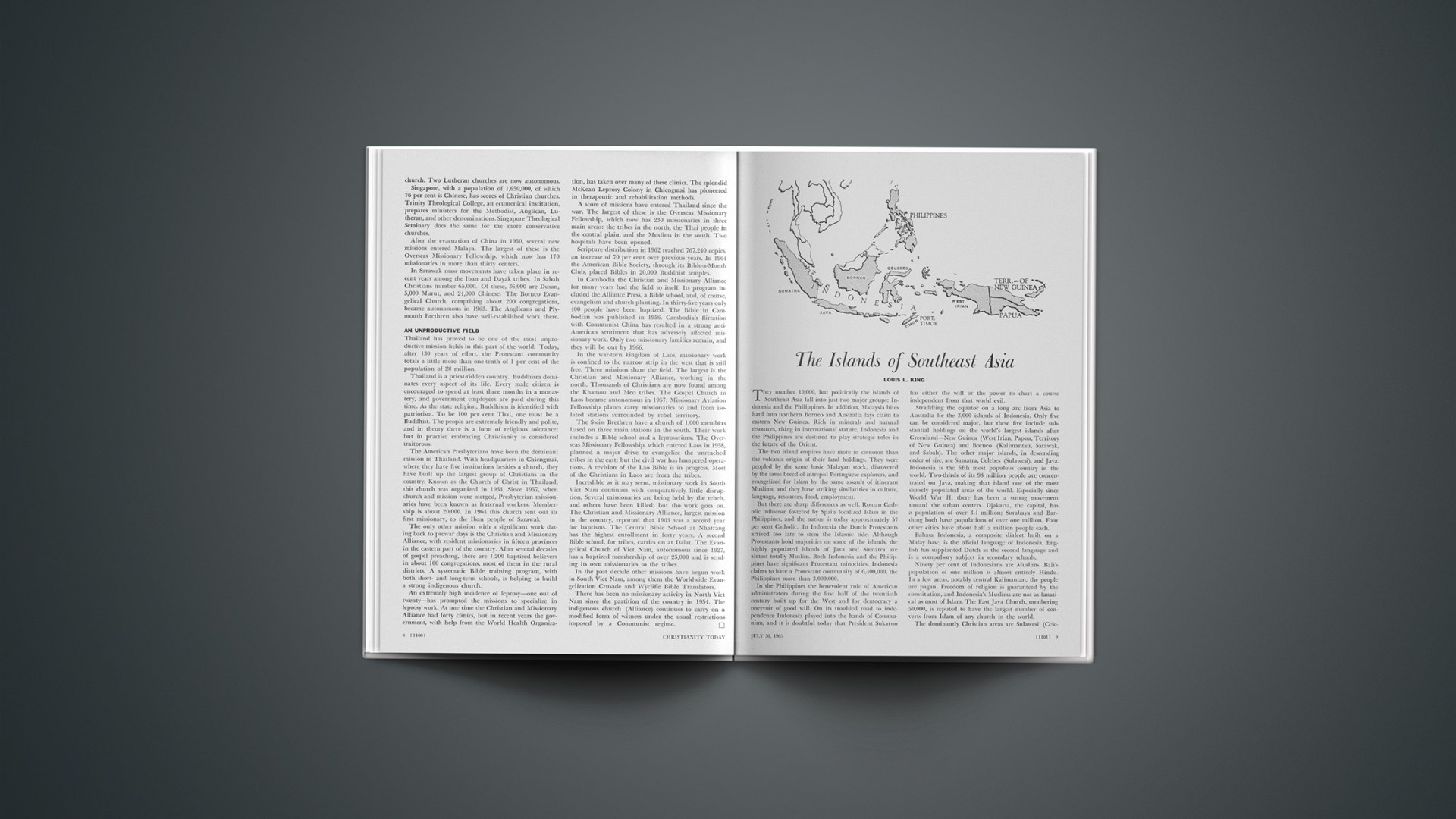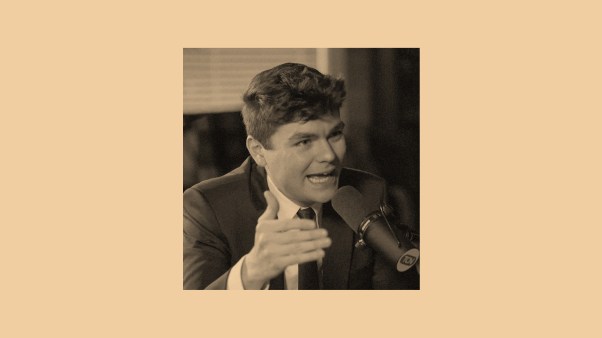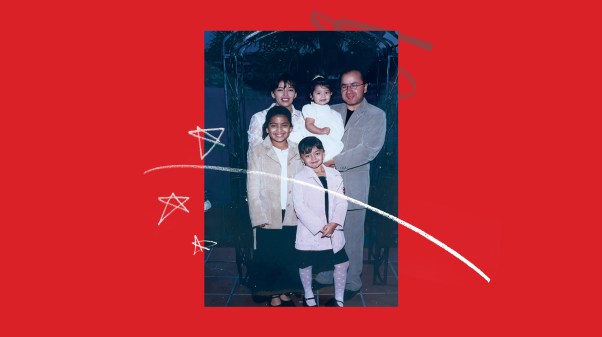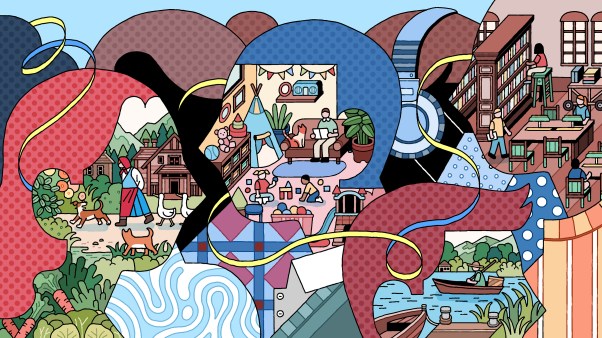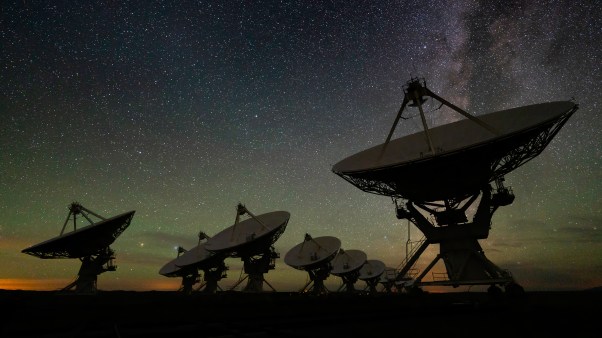They number 10,000, but politically the islands of Southeast Asia fall into just two major groups: Indonesia and the Philippines. In addition, Malaysia bites hard into northern Borneo and Australia lays claim to eastern New Guinea. Rich in minerals and natural resources, rising in international stature, Indonesia and the Philippines are destined to play strategic roles in the future of the Orient.
The two island empires have more in common than the volcanic origin of their land holdings. They were peopled by the same basic Malayan stock, discovered by the same breed of intrepid Portuguese explorers, and evangelized for Islam by the same assault of itinerant Muslims, and they have striking similarities in culture, language, resources, food, employment.
But there are sharp differences as well. Roman Catholic influence fostered by Spain localized Islam in the Philippines, and the nation is today approximately 57 per cent Catholic. In Indonesia the Dutch Protestants arrived too late to stem the Islamic tide. Although Protestants hold majorities on some of the islands, the highly populated islands of Java and Sumatra are almost totally Muslim. Both Indonesia and the Philippines have significant Protestant minorities. Indonesia claims to have a Protestant community of (6,400,000, the Philippines more than 3,000,000.
In the Philippines the benevolent rule of American administrators during the first half of the twentieth century built up for the West and for democracy a reservoir of good will. On its troubled road to independence Indonesia played into the hands of Communism, and it is doubtful today that President Sukarno has either the will or the power to chart a course independent from that world evil.
Straddling the equator on a long arc from Asia to Australia lie the 3,000 islands of Indonesia. Only five can be considered major, but these five include substantial holdings on the world’s largest islands after Greenland—New Guinea (West Irian, Papua, Territory of New Guinea) and Borneo (Kalimantan, Sarawak, and Sabah). The other major islands, in descending order of size, are Sumatra, Celebes (Sulawesi), and Java. Indonesia is the fifth most populous country in the world. Two-thirds of its 98 million people are concentrated on Java, making that island one of the most densely populated areas of the world. Especially since World War II, there has been a strong movement toward the urban centers. Djakarta, the capital, has a population of over 3.4 million; Surabaya and Bandung both have populations of over one million. Four other cities have about half a million people each.
Bahasa Indonesia, a composite dialect built on a Malay base, is the official language of Indonesia. English has supplanted Dutch as the second language and is a compulsory subject in secondary schools.
Ninety per cent of Indonesians are Muslims. Bali’s population of one million is almost entirely Hindu. In a few areas, notably central Kalimantan, the people are pagan. Freedom of religion is guaranteed by the constitution, and Indonesia’s Muslims are not as fanatical as most of Islam. The East Java Church, numbering 50,000, is reputed to have the largest number of converts from Islam of any church in the world.
The dominantly Christian areas are Sulawesi (Celebes), Sumatra, and Ambon. By comparison with other Asian countries, Indonesia has several large denominations. In northern Sulawesi the Church of Minahassa has a membership of over 350,000. Nine out of ten persons in Minahassa are Christians. The Church of the Moluccas has 275,000 adherents. The inhabitants of the island of Ambon are almost entirely Christian. The membership of the Church of Timor numbers 295,000, which is half of the island’s population. The Batak churches of northern Sumatra have close to one million members.
While these are impressive figures, they represent a Christian community strong on the fringes of the archipelago but very weak on the metropolitan island of java. Moreover, the Church exists in what is probably the largest Muslim state in the world, and a strong Masjumai party is decidedly anti-Christian. Since independence, the strong financial assistance once received from the Dutch government has been denied those belonging to the Protestant Church of Indonesia, once a state church, and some of the congregations are facing financial crises. More recently those same churches have experienced an embarrassing loss of young people to the Communist cause.
No adequate understanding of Indonesia is possible without an understanding of Sukarno, the man who personifies Indonesia. Active in the resistance movements against Dutch colonialism, Sukarno spent nine years in jail, stooped to become head of the Japanese puppet government during World War II, and emerged as head of the Indonesian revolutionaries by the time of the 1949 independence. With considerable skill he gained and held the loyalty of the Indonesian people, meanwhile effecting a series of constitutional changes that have made him dictator in fact if not in name. In world politics he has leaned ever farther to the left, and has now passed the point of no return. Aging (he is 62) and ailing (kidney disease), he has bankrupted his fabulously rich kingdom and brought the Far East perilously close to war in the pursuit of his personal aggrandizement and ambitions.
Missionaries are free to pursue their work in most of Indonesia, although deteriorating communications and runaway inflation are increasing irritants, and missionaries may no longer reside in eastern Kalimantan (Borneo). The flow of new visas has dried to a trickle, but as yet no efforts have been made to bar missionaries who return from furlough within the space of their return permits.
Can missions and missionaries weather the present and future tribulation in Indonesia? The calculated guess is affirmative, although considerable harassment is almost certain.
The Philippines are a triangular cluster of 7,000 volcanic islands that stretch 1,152 miles north and south between Formosa and Borneo. In area they exceed New York, New Jersey, Pennsylvania, and Delaware combined. Luzon on the north and Mindanao on the south are the largest of the islands.
The population, estimated at 30 million, ranges from primitive to highly cultured. Manila is a thriving metropolis with a population of three million. It reportedly has more college and university students than any other city in the world.
Discovered by Magellan in 1521 and possessed by Spain and the Roman Catholic Church for three centuries, the Philippines were ceded to the United States as part of the treaty ending the Spanish-American War. They attained independence in 1946. During nearly two decades the Republic of the Philippines has been the showcase of democracy in the Far East, its windows not always transparent but certainly not completely shrouded either.
To the church of Rome Protestant missionaries owe both a debt of gratitude and a vote of censure. It was Catholicism that stopped Islam’s penetration of the islands, but it was Catholicism’s determined priesthood that ruled for three centuries and still holds the majority in fear of sacerdotal retribution.
One church group listed as Protestant is the hard-to-classify Philippine Independent Church, with a membership of a million and a half. Popularly known as Aglipayan, after Father Aglipay, its early leader, it broke away from Rome in 1902 and is moving steadily toward closer communion with Protestants. It is the largest non-Catholic denomination in Asia.
Nationalism in the Philippines has developed slowly but inexorably. Several recent incidents involving American military personnel in the Philippines have depleted the reservoir of good will toward America.
There are some conditions highly favorable to the spread of evangelical Christianity in the Philippines: a large existing church, the anticlerical attitude and the nominality of many Catholics, great opportunities among the responsive tribal populations, a high degree of literacy, and the aggressiveness of lay Christians. Philippine Protestant churches may be expected to play an ever growing role in the evangelization of the archipelago as well as in the evangelization of the Orient.
New Guinea, the second largest island in the world, was discovered by the Portuguese in 1511. Because of the trying climate, rough terrain, and ferocious inhabitants, great portions remained unexplored until the past decade. Many of the people still have a Stone Age culture, and large areas remain dangerously savage.
The western section of New Guinea is governed by Indonesia and is called West Irian. The coastal church of West Irian, established more than a century ago by Dutch Reformed missionaries, is very large. In the more recently opened interior areas, there are large groups entering the Christian faith.
Eastern New Guinea, now called the Territory of Papua and New Guinea, is administered by Australia. It has the largest and fastest-growing Protestant church body in the South Pacific. In some areas, 40 per cent of the people are Christian.
The islands of Southeast Asia represent a continuing challenge to the Church of Jesus Christ. It is only reasonable that Christendom should press its advantage in areas that have been responsive to the Gospel.

